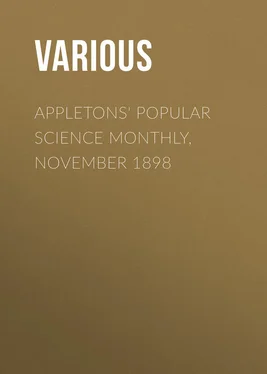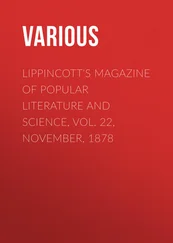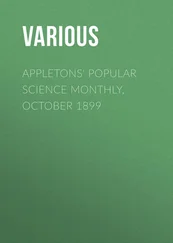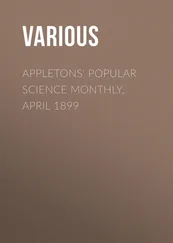Various - Appletons' Popular Science Monthly, November 1898
Здесь есть возможность читать онлайн «Various - Appletons' Popular Science Monthly, November 1898» — ознакомительный отрывок электронной книги совершенно бесплатно, а после прочтения отрывка купить полную версию. В некоторых случаях можно слушать аудио, скачать через торрент в формате fb2 и присутствует краткое содержание. Издательство: Иностранный паблик, Жанр: periodic, foreign_edu, на английском языке. Описание произведения, (предисловие) а так же отзывы посетителей доступны на портале библиотеки ЛибКат.
- Название:Appletons' Popular Science Monthly, November 1898
- Автор:
- Издательство:Иностранный паблик
- Жанр:
- Год:неизвестен
- ISBN:нет данных
- Рейтинг книги:5 / 5. Голосов: 1
-
Избранное:Добавить в избранное
- Отзывы:
-
Ваша оценка:
- 100
- 1
- 2
- 3
- 4
- 5
Appletons' Popular Science Monthly, November 1898: краткое содержание, описание и аннотация
Предлагаем к чтению аннотацию, описание, краткое содержание или предисловие (зависит от того, что написал сам автор книги «Appletons' Popular Science Monthly, November 1898»). Если вы не нашли необходимую информацию о книге — напишите в комментариях, мы постараемся отыскать её.
Appletons' Popular Science Monthly, November 1898 — читать онлайн ознакомительный отрывок
Ниже представлен текст книги, разбитый по страницам. Система сохранения места последней прочитанной страницы, позволяет с удобством читать онлайн бесплатно книгу «Appletons' Popular Science Monthly, November 1898», без необходимости каждый раз заново искать на чём Вы остановились. Поставьте закладку, и сможете в любой момент перейти на страницу, на которой закончили чтение.
Интервал:
Закладка:
It seems reasonable to believe that had the Chinese, Japanese, or Koreans visited the Mexican coast in such numbers as is believed they did, we ought certainly to find some influence, some faint strain, at least, of the Chinese method of writing in the hitherto unfathomable inscriptions of Maya and Aztec. Until recently it was not known whether they were phonetic or ideographic; indeed, Dr. Brinton has devised a new word to express their character, which he calls ikonomatic. This distinguished philologist of the American languages confesses that not even the threshold of investigation in the solution of these enigmatical puzzles has been passed. Had the Chinese introduced or modified or even influenced in any way the method of writing as seen on the rock inscriptions of Central America, one familiar with Chinese might have found some clew, as was the case in deciphering the ancient writings of Assyria and Egypt. Grotefend's work on cuneiform inscriptions and Champollion's interpretation of Egyptian came about by the assumption of certain inclosures representing historic characters, which were revealed in one case by an inference and in another by an accompanying Greek inscription. If we examine the early Chinese characters as shown on ancient coins of the Hea dynasty (1756 to 2142 B.C.), or the characters on ancient bronze vases of the Shang dynasty (1113 to 1755 B.C.), we find most of them readily deciphered by sinologists, and coming down a few centuries later the characters are quite like those as written to-day. On some of the many inscribed stone monuments of Central America one might expect to find some traces of Chinese characters if any intercourse had taken place, whereas the Maya glypts are remotely unlike either Chinese or Egyptian writing. Some acute students of this subject are inclined to believe that these undecipherable characters have been evolved from pictographs which were primarily derived from the simple picture writing so common among the races of the New World.
It seems clearly impossible that any intercourse could have taken place between Asia and America without an interchange of certain social commodities. The "divine weed," tobacco, has been the comfort of the races of the western hemisphere north and south for unnumbered centuries: stone tobacco pipes are exhumed in various parts of the continent; cigarettes made of corn husks are found in ancient graves and caves; the metatarsals of a deer, doubly perforated, through which to inhale tobacco or its smoke in some form, are dug up on the shores of Lake Titicaca.
The question naturally arises why tobacco was not carried back to Asia by some of the returning emigrants, or why tea was not introduced into this country by those early invaders. A Buddhist priest without tea or tobacco would be an anomaly. There are many other herbs, food plants, etc., that should not have waited for the Spanish invasion on the one hand, or the Dutch and Portuguese navigator along the Chinese coast on the other.
Finally, if evidences of Asiatic contact exist, they should certainly be found in those matters most closely connected with man, such as his weapons, clothing, sandals, methods of conveyance, pottery making and devices thereon, musical instruments, and above all house structure and modes of burial. More remote perhaps would be survivals of language, and if the invaders had a written one, the characters, whether phonetic or ideographic, would have been left in the enduring rock inscriptions. If now a study of the aborigines of the western hemisphere from Hudson Bay to Tierra del Fuego fails to reveal even a remote suggestion of resemblance to any of these various matters above enumerated, their absence must in some way be accounted for by Asiaticists.
THE POSSIBLE FIBER INDUSTRIES OF THE UNITED STATES
The wealth of any community is dependent on the variety and extent of its industries, the utilization of local natural resources, and the employment of the labor of all classes of its population. In locations of successful industrial operations the farmer derives increased incomes, the value of his products is greater, his lands of higher value, and the wages of agricultural labor larger. The rural population contiguous to large towns, therefore, is more prosperous than the larger farming contingent more remote from manufacturing or industrial centers. The farmers of the first class are prosperous because they have a home market for their dairy products, fruits, vegetables, and other "truck," which they are able to produce, for the most part, on small areas by high culture, while those of the second class are forced to expend their energies on commercial commodities such as cotton, wool, meat, grain, etc., with long hauls in transportation, and with heavy competition, international as well as domestic.
In times of depression, or when competition has grown too heavy, the cultivation of certain staples may cease to be remunerative, and the unfortunate producer is compelled to diversify his agriculture, or adopt some other means of livelihood.
Just such a misfortune has overtaken many farmers in the United States within the past few years. Within two years, in fact, wheat has been a drug in the market, while corn has been cheaper in some sections than coal, and cotton is now so low that it hardly pays to grow it, without considering the necessity, for the Southern farmer, of competing against the seventy-five thousand bales of Egyptian cotton which enter our ports in a year. Confronted with these conditions, there never has been a time when farmers were more anxious to discover new paying crops. Among the possible new rural industries that have attracted the attention of the agricultural class is that of fiber production, though the growth of certain kinds of fibers in past time has been a source of income to the country. Already there is a widespread interest in the subject throughout the West and South, and farmers are only seeking information regarding the particular practice involved in the cultivation of flax, ramie, and other fibers, cost of production, market, etc., but many are asking where the proper seed can be secured with which to make a start.
The importation of unmanufactured flax, hemp, textile grasses, and other fibers amounts annually to a sum ranging from fifteen million to twenty million dollars, while the imported manufactures of these fibers amount to almost double this value, or, in round numbers, approximately forty-five million dollars. With the establishment and extension of three or four fiber industries in this country, and with the new manufacturing enterprises that would grow out of such establishment and extension, an immense sum could be readily saved to the country, and the money representing the growth of these fibers would add just so much to the wealth of the farming class.
There are two ways in which we may arrive at a solution of this problem: by direct Government aid, and through the intelligently directed efforts of private enterprise.
Government experiments for the development or extension of vegetable fiber industries have been instituted, at different times, in many countries. In some instances these have been confined to testing the strength of native fibrous substances for comparison with similar tests of commercial fibers. Such were the almost exhaustive experiments of Roxburgh in India early in the present century. Another direction for Government experimentation has been the testing of machines to supersede costly hand labor in the preparation of the raw material for market, or in the development of chemical processes for the further preparation of the fibers for manufacture. The broadest field of experiment, however, has been the growth of the plants under different conditions, either to introduce their culture, or to economically develop the industries growing out of their culture, when such industries need to be fostered. The introduction of ramie culture is an example of the first instance, the fostering of the almost extinct flax industry of our grandfathers' days an illustration of the second.
Читать дальшеИнтервал:
Закладка:
Похожие книги на «Appletons' Popular Science Monthly, November 1898»
Представляем Вашему вниманию похожие книги на «Appletons' Popular Science Monthly, November 1898» списком для выбора. Мы отобрали схожую по названию и смыслу литературу в надежде предоставить читателям больше вариантов отыскать новые, интересные, ещё непрочитанные произведения.
Обсуждение, отзывы о книге «Appletons' Popular Science Monthly, November 1898» и просто собственные мнения читателей. Оставьте ваши комментарии, напишите, что Вы думаете о произведении, его смысле или главных героях. Укажите что конкретно понравилось, а что нет, и почему Вы так считаете.












